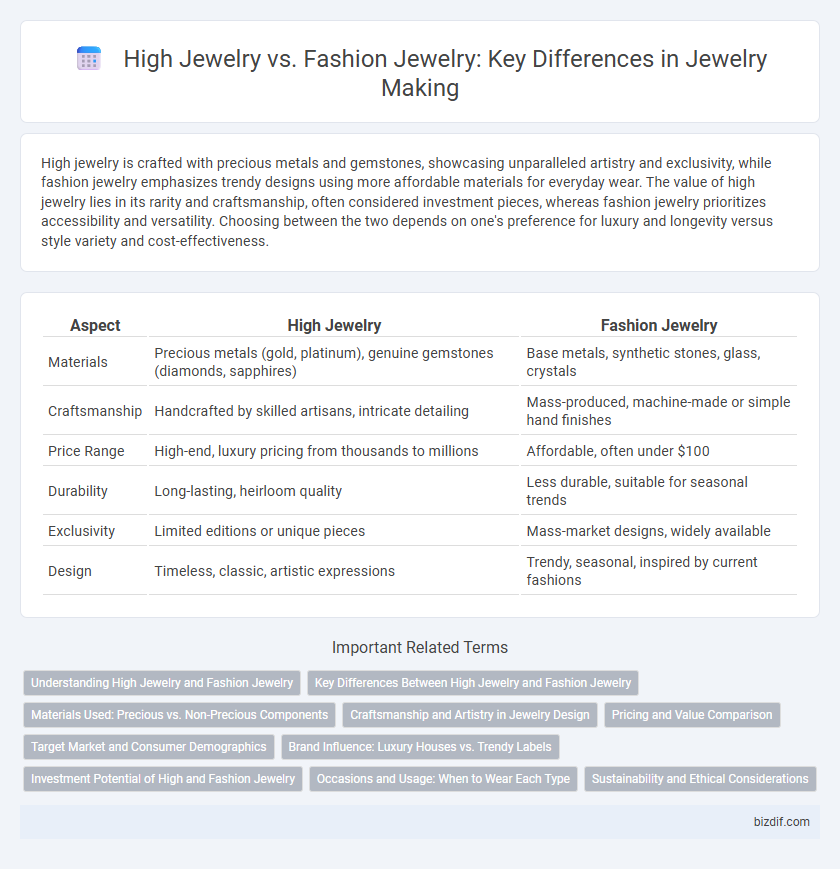High jewelry is crafted with precious metals and gemstones, showcasing unparalleled artistry and exclusivity, while fashion jewelry emphasizes trendy designs using more affordable materials for everyday wear. The value of high jewelry lies in its rarity and craftsmanship, often considered investment pieces, whereas fashion jewelry prioritizes accessibility and versatility. Choosing between the two depends on one's preference for luxury and longevity versus style variety and cost-effectiveness.
Table of Comparison
| Aspect | High Jewelry | Fashion Jewelry |
|---|---|---|
| Materials | Precious metals (gold, platinum), genuine gemstones (diamonds, sapphires) | Base metals, synthetic stones, glass, crystals |
| Craftsmanship | Handcrafted by skilled artisans, intricate detailing | Mass-produced, machine-made or simple hand finishes |
| Price Range | High-end, luxury pricing from thousands to millions | Affordable, often under $100 |
| Durability | Long-lasting, heirloom quality | Less durable, suitable for seasonal trends |
| Exclusivity | Limited editions or unique pieces | Mass-market designs, widely available |
| Design | Timeless, classic, artistic expressions | Trendy, seasonal, inspired by current fashions |
Understanding High Jewelry and Fashion Jewelry
High jewelry is crafted with rare gemstones, precious metals, and exceptional artistry, often representing investment pieces with unique designs and high craftsmanship standards. Fashion jewelry, also known as costume jewelry, uses more affordable materials like base metals and synthetic stones, designed for trendy, seasonal looks rather than long-term value. Understanding the distinction involves recognizing high jewelry's emphasis on exclusivity and durability, while fashion jewelry prioritizes accessibility and style variety.
Key Differences Between High Jewelry and Fashion Jewelry
High jewelry is crafted from rare, precious gemstones and metals such as platinum and 18k gold, emphasizing exceptional craftsmanship and exclusivity, while fashion jewelry uses more affordable materials like base metals, glass, or synthetic stones to offer trendy designs at accessible prices. The value of high jewelry is driven by its artistry, rarity, and potential for investment, whereas fashion jewelry prioritizes style variety and seasonal appeal over longevity. High jewelry pieces are often unique or limited editions, showcasing intricate techniques like hand engraving or gem setting, contrasting with mass-produced fashion jewelry that targets broader consumer markets.
Materials Used: Precious vs. Non-Precious Components
High jewelry exclusively utilizes precious materials such as gold, platinum, diamonds, and rare gemstones, ensuring exceptional durability and intrinsic value. Fashion jewelry often incorporates non-precious components like base metals, glass beads, and synthetic stones to achieve trendy designs at affordable prices. The choice of materials significantly influences both the longevity and market price of the jewelry piece.
Craftsmanship and Artistry in Jewelry Design
High jewelry demonstrates unparalleled craftsmanship and artistry, often handcrafted by master artisans using rare gemstones and precious metals, resulting in unique, intricate designs. Fashion jewelry emphasizes trendy aesthetics and affordability, typically produced through industrial methods with less focus on meticulous detailing or high-quality materials. The distinction lies in the skill level and artistic vision, with high jewelry prioritizing exquisite artistry and meticulous construction while fashion jewelry caters to mass appeal and accessibility.
Pricing and Value Comparison
High jewelry commands premium prices due to the use of rare gemstones, precious metals, and exceptional craftsmanship, often reflecting significant investment and intrinsic value. Fashion jewelry is priced more affordably, utilizing less expensive materials like base metals and synthetic stones, prioritizing trends and accessibility over longevity. The value of high jewelry often appreciates over time, whereas fashion jewelry tends to hold minimal resale value and depreciates quickly.
Target Market and Consumer Demographics
High jewelry targets affluent consumers who value exclusivity, craftsmanship, and rare gemstones, often appealing to collectors and luxury connoisseurs aged 35 and above. Fashion jewelry caters to younger demographics, typically women aged 18 to 35, seeking affordable, trendy, and versatile pieces for everyday wear. The target market for high jewelry emphasizes prestige and investment, while fashion jewelry focuses on accessibility and seasonal style.
Brand Influence: Luxury Houses vs. Trendy Labels
High jewelry is predominantly crafted by renowned luxury houses such as Cartier, Van Cleef & Arpels, and Bulgari, whose brand heritage and craftsmanship significantly elevate the pieces' value and exclusivity. Fashion jewelry, on the other hand, is often produced by trendy labels like Kate Spade or Pandora, which emphasize contemporary styles and accessibility rather than timeless artistry. The influence of luxury houses lies in their legacy and use of rare materials, while trendy labels leverage fast-moving trends and affordable designs to attract a broader audience.
Investment Potential of High and Fashion Jewelry
High jewelry, crafted from rare gemstones and precious metals, holds significant investment potential due to its intrinsic value, craftsmanship, and brand heritage, often appreciating over time. Fashion jewelry, typically made with less expensive materials and designed for trends, tends to have minimal long-term financial value and rarely serves as a sound investment. Collectors and investors prioritize high jewelry pieces from renowned brands like Cartier and Van Cleef & Arpels for portfolio diversification and wealth preservation.
Occasions and Usage: When to Wear Each Type
High jewelry, crafted with rare gemstones and precious metals, is ideal for formal occasions, gala events, and weddings, adding a luxurious and statement-making touch to elegant attire. Fashion jewelry, made from more affordable materials, suits everyday wear, casual outings, and trendy ensembles, allowing for frequent style updates and experimentation. Selecting the right type depends on the event's formality, personal style, and desired durability.
Sustainability and Ethical Considerations
High jewelry prioritizes sustainability through the use of ethically sourced gemstones and recycled precious metals, minimizing environmental impact and supporting fair labor practices. Fashion jewelry often relies on inexpensive materials and mass production techniques, which can contribute to environmental degradation and exploitative labor conditions. Choosing high jewelry promotes a more sustainable and ethical approach to accessory consumption, aligning with growing consumer demand for responsible luxury.
High jewelry vs Fashion jewelry Infographic

 bizdif.com
bizdif.com